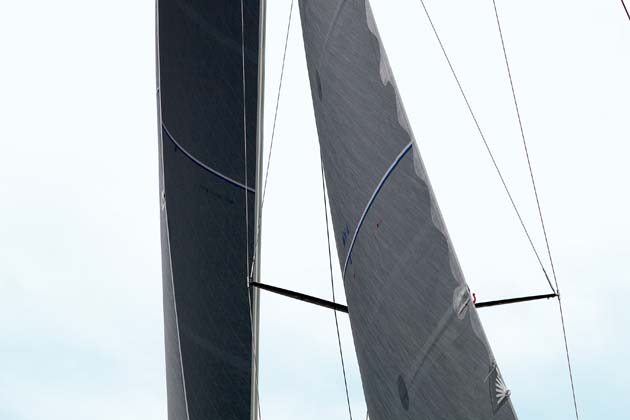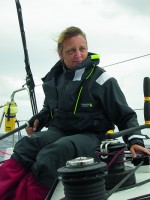Pip Hare describes how to change your style of sailing for going upwind short-handed when you haven’t got crew on the rail
Excessive heel is your enemy when sailing upwind, and with no hiking crew this is something the double-handed sailor needs to consider. To sail upwind well you must learn the optimum angle of heel for your boat and then stick to it, adapting your style to allow for the lack of readily available righting moment. Over time you will get the feel of when the angle is not right, even down below.
A short-handed helmsman needs to think about and feel the whole boat; it’s not just about driving, but actively trimming with the traveller and/or mainsheet to maintain a continuous, smooth angle of heel. The backstay can also be a very effective upwind trimming tool so don’t just set and forget.
Helming position
Spend time setting up your helming position. Can one person easily steer and reach the relevant controls with the other hand? If the traveller is rough and hard to pull with one hand eventually you will give up using it and just sail badly. On boats with larger wheels the helmsman may need to sit either astride or in front of the wheel to reach the mainsheet controls.

Can you reach all the controls from your helming position?
Try twisting off the headsail in larger waves to give a smoother ride. This will often help if you are not able to control gust response with the traveller, but will require a different style of helming, ‘feathering’ the boat in gusts so the inside jib telltale is lifting more often, but the boat is flat. This technique requires practice, but is particularly useful in big waves at night.
With no crew on the rail, helming is definitely a wetter experience for the short-handed sailor. There is no way around this. Use it as an excuse to buy a really good set of foulies – consider dry seals if your boat is really wet – then get out there and get on with it.
Use the autopilot
As helming is a much more active experience for the short-handed sailor you will get tired more quickly. We know it is easy to go slow when sailing upwind so keep a copy of your target speeds in view and constantly refer to them. If you are struggling to keep up then let the autopilot take the strain.
The autopilot is a great tool upwind, but don’t just turn it on and walk away. Set it to steer in apparent wind mode and one or two degrees lower than you would normally helm; sit by the helm and trim the traveller to give the smoothest ride, watching the size of helm corrections the pilot is applying as a guide.

Try twisting off the headsail in larger waves for a smoother ride
Tuck in a reef if the pilot looks to be struggling. But if the pilot is coping well, you can use upwind time to carry out maintenance, eat, sleep and plan.
Reefing
Reefing short-handed should not require two on deck and is relatively straightforward, but do adapt your safety controls if doing it alone. Drop the traveller to depower the main before releasing the halyard and double check your pilot is still coping with the course under the new balance of the boat before you go forward.
Before night falls mark your sheets and jib cars with electrical tape when you are confident the boat is sailing well. It is really easy to mess up your sail trim on a dark night and if it all goes wrong you will then have a good base setting to return to as a last resort.
Quick tips
- Splice marks into your main halyard so you know exactly the point to which to lower the main for each reef.
- Practise feeling your angle of heel for night-time helming by sailing upwind with your eyes closed or even facing backwards.
- Put small elastic hoops on the gooseneck fitting to hold reefing rings onto the ram’s horns until the main halyard tension is
back on. - In conditions that challenge your speed, consider shorter watches to help your concentration and remember to keep food and drink to hand to avoid long periods away from the deck.
- Talk to your sailmaker about re-rating the boat for non-overlapping headsails; without a crew on the rail you may find the wind range for your No 1 becomes too small to be worth it.

Single-handed ocean sailor Pip Hare has clocked up thousands of miles racing and cruising. Among her achievements are five solo transatlantics, including the OSTAR and two Mini Transat races. She also works full-time for the RNLI on sea safety and is Consulting Editor on Yachting World. See her gear test on weather routeing packages
See also Pip’s fascinating series on advanced sailing techniques: SAIL FASTER SAIL SAFER




